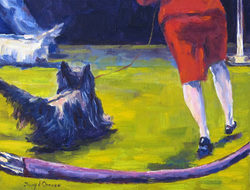
Tails. If you show your dogs, your breed dictates whether you want that tail up, down, or whether your dog has a tail at all. Depending upon the breed, some dogs rely on their tails for balance, others use them as rudders in the water. When your dog gaits in a show ring or out in the yard, however, the same fundamentals apply regardless of breed.
Dog tails are direct outgrowths of their spine, the bones in that spine called “vertebrae.” Inside, a dog’s tail is made up of a string of highly mobile bones, typically between six and twenty-three of them. Little muscles are attached to the bones, and when a dog wags, or holds his tail or up down, he’s using these little muscles. The caudal muscles lie on the lumbar vertebrae, sacrum (in the lower back area) and tail vertebrae, and the muscles insert on the tail exclusively attached to the tail vertebrae by tendons.
The three major muscle groups that lift your dog’s tail are connected to the dorsal muscles in her back. They are “a little” involved in the lumbar muscle group, but they don’t have much “say” about your dog’s gait, probably because they’re not involved with any of the muscles of the limbs.
When your dog moves, she may hold her tail up like a flag for all to salute, or tuck it between her legs, and that’s determined by your dog’s attitude. How she uses her tail is called carriage. Her tail set, however (where her tail goes into her body), is dictated solely by genetics and her physical structure, such as the angle of her croup (the muscular part on the rump of the dog). Needless to say, it’s a big topic grossly simplified for a short post.
We leave with a legend about the tail.
Once upon a time, a rich man owned a cat and dog, both of which had served him well. The dog was getting on in years, and though his teeth were mostly gone, he was a reliable guide and provided companionship to the cat. The cat, meanwhile, was sly, strong, and cunning.
When the master wished to send a gift to his daughter away at school some distance from home, he often sent the dog and cat to take the presents to her. One day, he called his faithful animals and bade them to carry a magic ring to his daughter. “You are strong and brave,” he said to the cat “You can carry the ring, but you must be extra careful not to drop it.” To the dog he said, “Accompany the cat, guide her, and keep her from harm.”
The dog and cat promised to do their best, and started out. Things were going well until they came to a river flowing strong with currents. With no boat or bridge, they were forced to swim.
“Let me take the magic ring,” said the dog as they were about to dive into the water.
“Hell no,” replied the cat,”the master gave it to me to carry” (the cat cussed when out of earshot of his master).
“But you don’t swim well,” argued the dog. “I’m strong, and I can take good care of it.”
The two bickered until the dog threatened the cat with an unpleasant outcome, and only then did the cat reluctantly gave the ring to the dog.
The distance between the shores was far, and the river was swift. They grew very tired, and just before they reached the bank, the dog dropped the ring. They looked everywhere, but couldn’t find it, and with great reluctance, they turned back to tell their master what had happened. The loyal dog, overcome with the fear of disappointing his master, ran away just before reaching the house and never was seen again. The cat went on alone having to explain how the ring was lost, and that the dog had run away.
The master was furious. He commanded that everyone search for the dog, and when found, that his tail be cut off. He also ordered that all the dogs in the world should join in the search.
Ever since then when dogs greet another, one dog says, “Are you the old dog that lost that magic ring?” The other dog immediately shows his teeth, then wags his tail to prove that he’s not the guilty dog. Cats don’t emerge from this fable unscathed. Ever since the incident, cats have been afraid of water and will not swim across a river if they can avoid it.
“Allison and Dillon” by Terry d. Chacon
http://www.terrydchacon.com/pet-portraits.html
https://www.facebook.com/terryd.chacon
